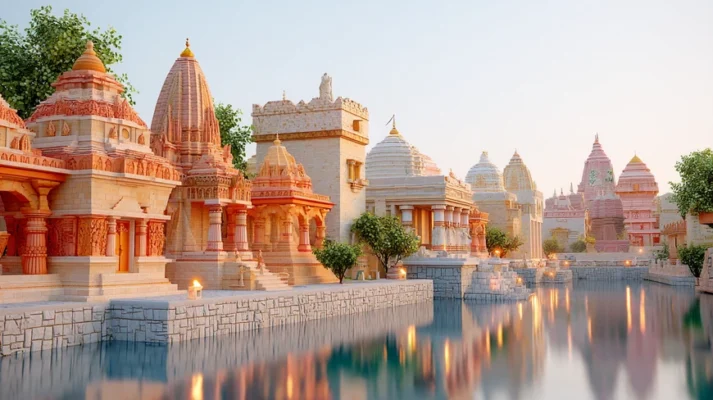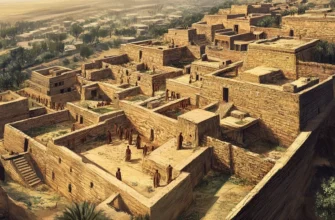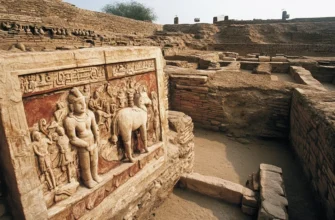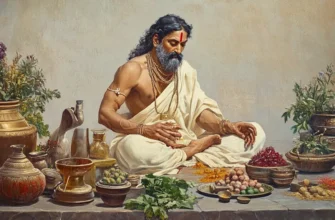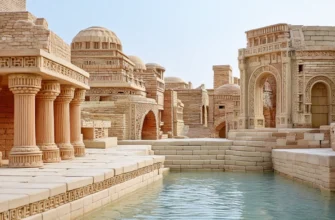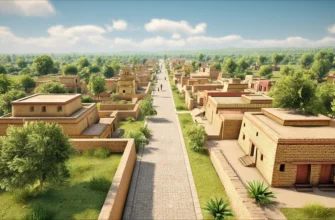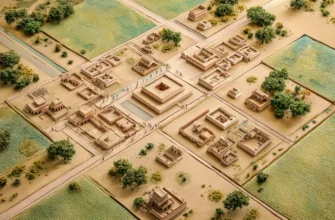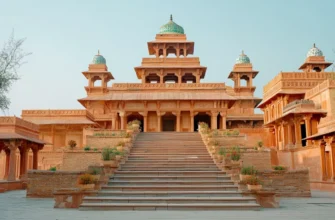Ayodhya is one of the oldest cities in India, located in the state of Uttar Pradesh. It is mentioned in sacred Hindu texts, including the Ramayana, as the birthplace of Lord Rama, the seventh incarnation of Vishnu.
Historically, Ayodhya was the capital of the Kosa state and an important center of culture and trade. The city played a significant role in the development of Hinduism, Jainism, and Buddhism. Today, it remains an important pilgrimage site, home to temples and historical monuments, including Ram Janmabhumi, a temple built on the site believed to be the birthplace of Rama.
Modern Ayodhya is actively developing as a tourist and spiritual center, preserving its unique historical and cultural heritage.
- Historical overview of the city
- Role in the development of civilization
- Religious significance
- Ayodhya as a sacred city
- The cult of Rama and his connection to the city
- Main temples and shrines
- Historical disputes surrounding the temples
- Impact on art and literature
- The city’s development in the 21st century
- Conclusion
Historical overview of the city
Ayodhya is one of the oldest cities in India, with a history dating back thousands of years. It was the capital of the ancient kingdom of Kosala, mentioned in Hindu scriptures.
In ancient texts, including the Ramayana, the city is described as developed, rich, and prosperous. It is believed that the god Rama, the seventh incarnation of Vishnu, was born here.
Over the centuries, Ayodhya has remained an important religious center. Not only Hinduism, but also Buddhism and Jainism developed here. In the Middle Ages, the city experienced periods of decline and revival, particularly due to changes in rulers.
Today, Ayodhya is an important spiritual and cultural center, attracting pilgrims and tourists from all over the world.
Ayodhya in ancient texts
Ayodhya is mentioned in many ancient Indian texts, including the Ramayana, Mahabharata, and Vedic and Puranic sources.
The Ramayana describes Ayodhya as the prosperous capital of the kingdom of Kosala, ruled by King Dasharatha, father of the god Rama. The city is considered the birthplace of Rama and has sacred significance for Hindus.
The Atharva Veda mentions Ayodhya as a divine city endowed with wealth and spiritual power.
The Mahabharata points to Ayodhya’s role as an important political center in ancient India.
The Puranas contain numerous references to Ayodhya as a place of pilgrimage and a center of Hindu spirituality.
These texts confirm that Ayodhya has been not only an administrative center but also a center of religious life since ancient times.
Role in the development of civilization
Ayodhya played an important role in the formation of ancient Indian civilization, influencing religion, culture, architecture, and the political system.
Political center: Ayodhya was the capital of the ancient kingdom of Kosala, one of the most powerful states in Indian history. A system of government combining religious and administrative principles developed here.
Religious influence: As the birthplace of the god Rama, the city became a center of worship for Vishnu. Ayodhya also played a role in the development of Buddhism and Jainism, as several Jain tirthankaras were born here according to legend.
Cultural center: The city inspired the creation of epic literature, including the Ramayana. It influenced the art, theater, and folk traditions of India.
Economic development: Ayodhya was an important trading center, which contributed to the development of crafts, agriculture, and the exchange of knowledge between regions.
Thanks to its centuries-old history and influence on culture and religion, Ayodhya remains a landmark city for the entire Indian civilization.
Religious significance
Ayodhya is one of the most important religious cities in India, sacred to Hindus, Jains, and Buddhists.
Center of worship for Rama: In Hinduism, Ayodhya is considered the birthplace of the god Rama, the seventh incarnation of Vishnu. Because of this, the city is an important pilgrimage center, and the Ram Janmabhoomi Temple is its main shrine.
Significance for Jainism: According to legend, several Jain tirthankaras were born here, including Rishabhadeva, the first of the 24 enlightened teachers of Jainism. The city has ancient Jain temples that attract pilgrims.
Buddhist heritage: In ancient times, Ayodhya was one of the centers of Buddhism. There were Buddhist monasteries and stupas here, which testified to the spread of Buddha’s teachings in the region.
Sacred city in Vedic texts: Ayodhya is mentioned in the Vedas and Puranas as one of the seven holiest cities in India (Sapta Puri), where the attainment of moksha (liberation from the cycle of rebirth) is considered most auspicious.
Thanks to its centuries-old religious significance, Ayodhya remains an important center of spiritual life and pilgrimage for millions of people.
Ayodhya as a sacred city
Ayodhya is one of the seven sacred cities of India (Sapta Puri), where, according to Hindu beliefs, one can attain moksha (liberation from the cycle of rebirth).
Birthplace of Rama: According to legend, the god Rama, the seventh incarnation of Vishnu, was born in Ayodhya. Because of this, the city became the main center of the cult of Rama and an important place of pilgrimage.
Ram Janmabhumi Temple: The main shrine of Ayodhya, built on the site believed to be the birthplace of Rama. The temple attracts millions of pilgrims every year.
Other shrines: Ayodhya is home to numerous temples, ashrams, and sacred water bodies, including the Hanumanagarhi Temple, dedicated to Hanuman, Rama’s divine servant.
Significance for Jains: Ayodhya is considered the birthplace of the first Tirthankara, Rishabhadeva, making the city sacred to followers of Jainism.
Ayodhya is not only an important religious center, but also a symbol of spirituality and traditions that have been preserved here for thousands of years.
The cult of Rama and his connection to the city
Ayodhya is the central place of worship for the god Rama, the seventh incarnation of Vishnu, and plays a key role in the development of the Ramanuja tradition of Hinduism.
Birthplace of Rama: According to the Ramayana, Rama was born in Ayodhya as the son of King Dasharatha. This made the city the main center of the cult of Rama and his birthplace a shrine for millions of believers.
Ram Janmabhumi: One of the most important temples in Ayodhya, considered the birthplace of Rama. It is a place of mass pilgrimage.
Festivals in honor of Rama: Every year, Ayodhya celebrates Ram Navami (Rama’s birthday) and Diwali, which, according to legend, marks Rama’s return to Ayodhya after his victory over Ravana.
Temples and ashrams: In addition to Ram Janmabhumi, the city has many other temples dedicated to Rama and his companions, such as Hanuman Garhi, a temple dedicated to Hanuman, Rama’s faithful servant.
The cult of Rama in Ayodhya has a thousand-year history, and the city remains a spiritual center of worship for followers of Hinduism around the world.
Main temples and shrines
Ayodhya is an important religious center, home to numerous temples and shrines of great significance to Hindus and other religious groups. Here are some of the main ones:
Ram Janmabhumi
Birthplace of Rama: This is the most important shrine in the city. Built on the site where, according to legend, the god Rama was born, the temple is a major destination for pilgrims. It is also one of the most famous and controversial shrines in India, attracting millions of devotees every year.
Hanuman Garhi Temple
Dedicated to Hanuman: Hanuman is a devoted servant of Rama, and this temple is an important place of worship for those who revere this god. The temple is located on a hill and is one of the main shrines for Hindus, especially during the Hanuman Jayanti festival.
Kanak Bhavan Temple
Dedicated to Rama and Sita: This temple is located in the heart of Ayodhya and is dedicated to the divine couple Rama and Sita. The temple is known for its architectural beauty and contains statues of Rama and Sita accompanied by their sons Lava and Kusha.
Tapovan Temple
Ram’s Meditation Site: Located just outside the city, Tapovan Temple is associated with the legend of how Ram spent his time in meditation and austerities during his exile. It is a place of peace and quiet prayer.
Narayan Temple
Dedicated to Vishnu: The Narayan Temple in Ayodhya is known for its ancient history and is considered one of the places where Vishnu is worshipped, as Rama is his avatar.
Punehari
A sacred place for purification: This is a sacred bathing place mentioned in the Puranas and is part of the purification rituals and pujas in honor of Rama.
These temples and shrines have made Ayodhya an important pilgrimage center, attracting people not only from India but from all over the world to pay homage to Rama and other deities.
Historical disputes surrounding the temples
Ayodhya has been the scene of several important historical disputes related to its temples, particularly regarding Ram Janmabhumi, the place where, according to Hindu tradition, the god Rama was born. These disputes have been important for both the religious and political history of India.
The dispute over the birthplace of Rama:
The most famous dispute concerns the site where Ram Janmabhumi was built. In Hindu tradition, this place is considered sacred because it is where the god Rama was born. In the 16th century, the Babri Masjid (mausoleum) was built on this site, causing prolonged disputes between Hindus and Muslims. Hindus claimed that the mosque was built on the site of a destroyed Hindu temple dedicated to Rama.
Destruction of the Babri Masjid (1992):
In 1992, a group of Hindu activists destroyed the Babri Masjid, leading to widespread violence and inter-religious conflict across India. This destruction caused a huge political and social uproar, dividing the country along religious lines.
Indian Supreme Court ruling (2019):
After decades of legal disputes, in 2019, the Supreme Court of India handed down a historic ruling allowing the construction of a new Ram temple on the site of the Babri Masjid. The court recognized that the site is sacred to Hindus, but also granted land to the Muslim community for the construction of a new place of worship.
Political implications:
The dispute over the Ram temple in Ayodhya was not limited to religious aspects, but became an important part of the political process in India. The dispute was often used by political forces to mobilize the electorate, leading to significant changes in the country’s political landscape.
Current situation:
Since 2020, construction of the Ram temple has been underway at the site of the Babri Masjid, actively supported by the Indian government and Hindu organizations. This has become a symbol of the revival of Hindu worship in Ayodhya. However, disputes surrounding this issue remain sensitive and could cause tension in religious and political circles.
The disputes surrounding the temples of Ayodhya are an example of how religious symbols can become the focus of important social, political, and cultural conflicts.
Impact on art and literature
As a sacred city, Ayodhya has had a profound influence on the development of Indian art and literature, particularly in the context of Hindu, Buddhist, and Jain cultures. The city, associated with the life of Rama, has been a source of inspiration for numerous works of art, literary works, and artistic movements.
Ramayana and literary tradition:
Ayodhya is a key location in the Ramayana, an epic poem describing the life of Rama. It has had an enormous literary influence on the entire Indian and South Asian culture. The story of Rama’s exile, his battle with the demon Ravana, and his return to Ayodhya after victory has been the basis for numerous poems, dramas, and literary works in Sanskrit, Hindi, and other languages.
For example, Tulsidas created his version of Ramacharitmanas, one of the greatest classical poems in Hindi, which glorifies the life of Rama and his relationship with Sita, Lava, and Kush. This poem greatly influenced the popularization of Rama’s culture in India.
Temple art and architecture:
Ayodhya became a source of inspiration for Hindu temple art. Temples dedicated to Rama became models for architectural styles that spread widely throughout India. The architectural style of the temples in Ayodhya includes huge columns, stone carvings, and mosaics depicting scenes from the Ramayana, such as Rama’s exile and his return to Ayodhya.
For example, the Kanak Bhavan has numerous carved panels depicting Rama and other characters from the epic. The stylistic features of the temples became the basis for other temple complexes in India.
Folklore and oral tradition:
Many folklore stories related to the life of Rama are widespread in Ayodhya and have been passed down through generations. Different regions of India have created versions of these stories in the form of songs, fairy tales, and theatrical performances. These oral traditions preserve the connection between generations and keep the cult of Rama alive in Indian cultural life.
Theater and drama:
The influence of Ayodhya is also felt in Indian theater. For example, Kathakali and Kathak are traditions that interpret stories from the Ramayana and other Hindu epics in the form of dramatic performances combining music, dance, and drama. Performances about Rama, Sita, and Hanuman are very popular on Indian theater stages.
Painting and sculpture:
In the visual arts, Ayodhya has inspired numerous works of art, including paintings and sculptures depicting scenes from the Ramayana, such as the battle between Rama and Ravana or the scene of Rama’s exile. Artists often depict this city as an ideal sacred, spiritual space, giving it a solemn and majestic appearance.
Contemporary influence on pop culture:
Ayodhya continues to inspire contemporary authors, filmmakers, and artists. In particular, film adaptations of the Ramayana have formed the basis for numerous films and television series, both in India and abroad. Contemporary novels and adaptations of the Ramayana epic based on the life and events associated with Ayodhya continue to be popular in the Indian cultural milieu.
Ayodhya’s influence on Indian art and literature is extremely profound. The city has become a symbol of spiritual and cultural revival, which is not only preserved in sacred texts but also actively lives on in contemporary art, literature, and cultural practices in India.
The city’s development in the 21st century
Ayodhya in the 21st century is undergoing a period of significant change, including economic development, religious revival, and urban transformation. The city, which has always been an important religious and cultural center, is now actively developing, strengthening its status as one of India’s major pilgrimage centers.
Construction of the Ram Temple
One of the most significant projects of the 21st century is the restoration of the Ram Temple on the site of the Babri Masjid, which is actively underway following the 2019 decision of the Supreme Court of India. The construction of the new temple is part of the religious and cultural revival of the city, which is attracting pilgrims and tourists from all over the world. In addition to the temple itself, infrastructure is also being developed, including the creation of large worship areas, new roads, and parks.
Tourism and economic development
As Ayodhya has become an important tourist and pilgrimage center, the city is experiencing a significant economic boom. Hotels, restaurants, shopping centers, and tourist infrastructure are being built to ensure a comfortable stay for millions of visitors each year. In addition, the Indian government actively supports the development of the tourism industry, including special programs for the development of religious tourism.
Transport infrastructure
To accommodate the growing flow of tourists and pilgrims, Ayodhya is actively developing its transport infrastructure. In particular, the city is developing a network of bus and rail routes, and a new international airport is being built, which will greatly facilitate access to the city. These projects aim to make Ayodhya more accessible to visitors from other parts of India and the world.
Modernization of urban infrastructure
As part of the overall development of the city, the electricity and water supply networks are being modernized and new infrastructure facilities are being created to improve the quality of life of local residents. Programs for environmental conservation and the development of green areas are also part of the urban development plan.
Cultural revival and heritage preservation
In the 21st century, considerable attention is being paid to the preservation of Ayodhya’s cultural and religious heritage. Ancient temples, libraries, and architectural monuments are being restored. The city actively hosts cultural festivals and religious celebrations that attract tourists and promote the development of the culture and arts industry.
Development of the local economy
The growth of tourism has contributed to the development of the local economy, especially in the hospitality, trade, and service sectors. The city has become a center for entrepreneurs engaged in the manufacture of souvenirs, religious items, and the organization of tours. This stimulates the development of small and medium-sized enterprises.
Social changes
The development of Ayodhya also affects the social life of the city. Thanks to the improvement of the economic situation and the development of infrastructure, the standard of living of local residents is rising. The city is actively working on educational programs, creating new schools and medical facilities, which contributes to improving the quality of life of its citizens.
In the 21st century, Ayodhya is undergoing a period of profound transformation. The restoration of the Ram Temple, infrastructure development, growth in tourism, and cultural initiatives are together creating a new economic and social dynamic for the city. At the same time, the city preserves its religious and cultural heritage, making it an important center for pilgrims and tourists from all over the world.
Conclusion
Ayodhya is not only a historical but also a spiritual center that preserves centuries-old traditions and cultures that are of great importance to India and the whole world. As one of the oldest cities in India, Ayodhya combines a wealth of history, religious faith, and cultural heritage. Thanks to its close association with the Ramayana, it has become a symbol of heroism, piety, and loyalty, cementing its place in the hearts of millions of Hindus around the world.
The spiritual heritage of the city is extremely important to the Hindu religious tradition, as Ayodhya is one of the holiest places for pilgrims who visit it to offer their prayers to Rama and perform purification rituals. Today, the city combines its spiritual heritage with modern development, becoming an important center of religious tourism that attracts millions of visitors from all over the world.
The significance of Ayodhya is not limited to India; its history and culture have a global impact, as the city is a symbol of unity and cultural richness that brings together people of different nationalities and faiths.
The restoration and modernization of the city contribute to its development as an important center of spiritual and cultural significance, promoting not only economic but also social and cultural development in the region and the world as a whole.
Ayodhya remains a living part of the world’s heritage, continuing to influence the spiritual and cultural consciousness not only in India but also on the international stage.
